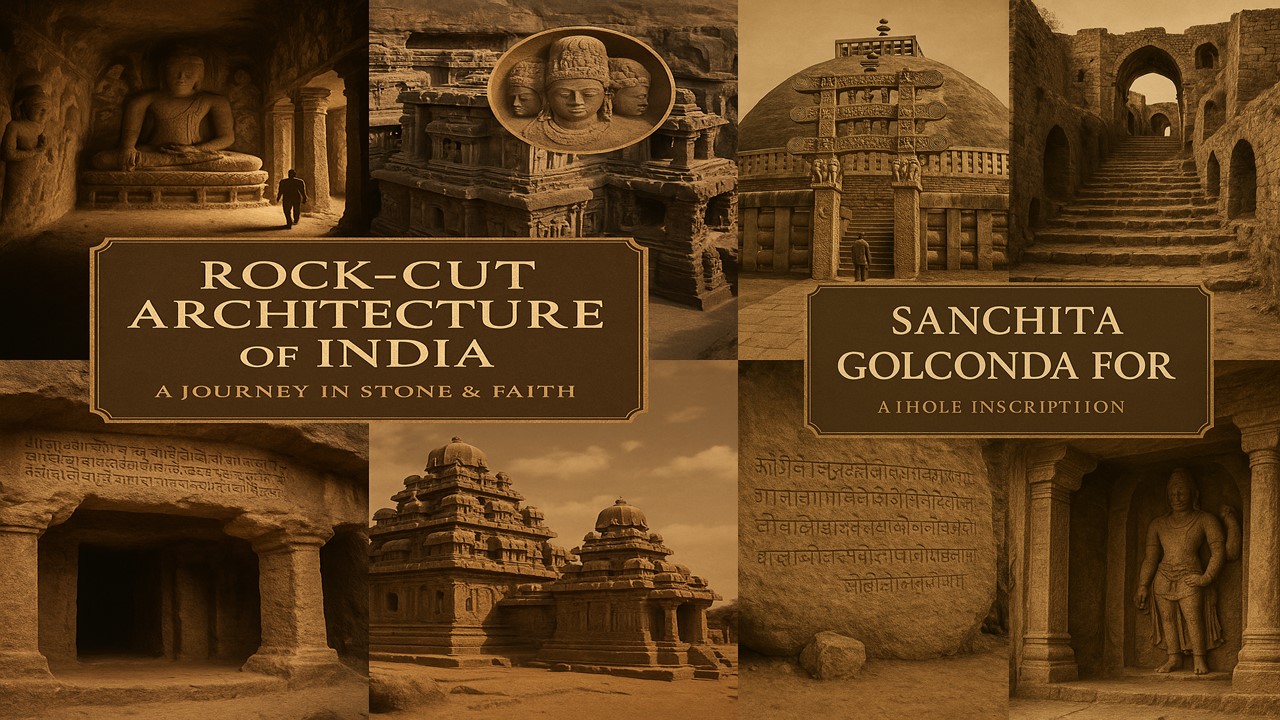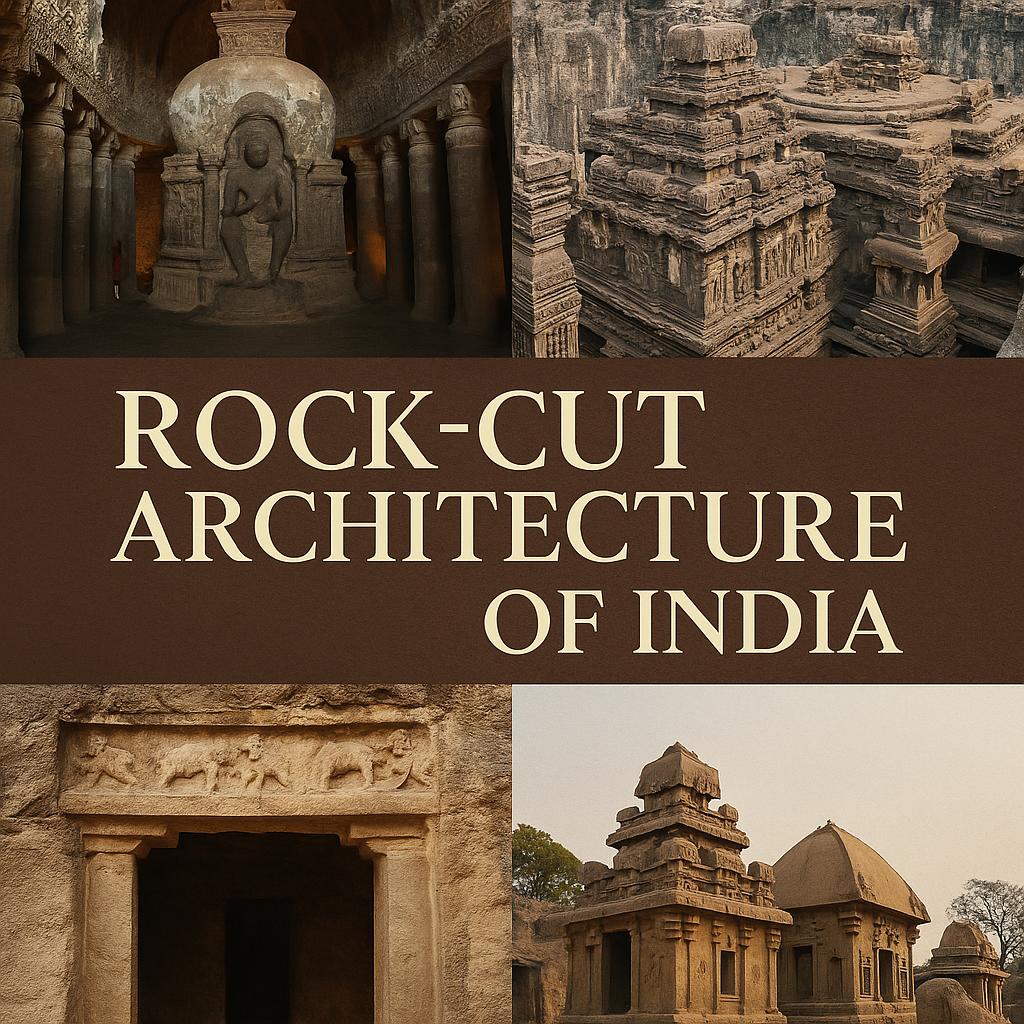
Rock-Cut Architecture in India
Rock-Cut Architecture in India, focusing on historical depth, stylistic analysis, and cultural significance. This version is suited for academic essays or university-level study.
Rock-Cut Architecture in India
Introduction
Rock-cut architecture in India represents a sophisticated blend of art, religion, and engineering. Carved directly into natural rock formations, these structures—temples, monasteries, and shrines—demonstrate not only the technological skills of ancient Indian craftsmen but also the spiritual and political contexts that shaped their creation. Spanning centuries and dynasties, this architecture is deeply connected with Buddhist, Hindu, and Jain religious practices.
Examples and Analysis
1. Ajanta Caves (2nd century BCE – 6th century CE) – Maharashtra
- Dynasties: Satavahanas, Vakatakas
- Religious Context: Theravāda and Mahāyāna Buddhism
- Architectural Features:
- Comprises 30 caves, primarily chaitya halls (prayer halls) and viharas (monastic quarters).
- Use of horseshoe-shaped façade, vaulted ceilings, and carved pillars.
- Artistic Significance:
- Murals illustrating Jātaka tales—narratives of the Buddha’s past lives.
- Demonstrates the transition from Hinayana to Mahayana Buddhism.
- Stylistic Impact:
- Early experimentation with narrative painting and perspective.
- Naturalistic forms and emotional expressions signal a high point in Indian mural tradition.
2. Ellora Caves (6th–10th centuries CE) – Maharashtra
- Dynasties: Kalachuri, Rashtrakuta, Chalukya
- Religious Pluralism:
- 34 caves: 12 Buddhist, 17 Hindu, and 5 Jain.
- Highlight: Kailasa Temple (Cave 16):
- World’s largest monolithic rock-cut temple.
- Represents Mount Kailash; carved top-down from a single rock.
- Intricate relief sculptures depicting episodes from Ramayana and Mahabharata.
- Significance:
- Syncretic religious space reflecting medieval religious tolerance.
- Architectural innovation in scale, planning, and execution.
3. Elephanta Caves (5th–8th century CE) – Maharashtra
- Patronage: Likely Kalachuri dynasty
- Religious Focus: Shaivism
- Architectural Features:
- Main cave (Cave 1) houses the Trimurti—a 20-foot high sculpture of Shiva as creator, preserver, and destroyer.
- Complex spatial planning with mandapa (pillared hall) and garbhagriha (sanctum).
- Interpretation:
- The divine triad reflects Indian metaphysics and cosmic symbolism.
4. Badami Caves (6th century CE) – Karnataka
- Dynasty: Chalukyas of Badami
- Religious Representation: Hinduism, Jainism
- Architectural Typology:
- Four caves: three Hindu (Vaishnava and Shaiva themes) and one Jain.
- Use of sandstone; decorative lintels, ceiling panels, and deeply cut sculptures.
- Notable Sculptures:
- Vishnu in Trivikrama and Varaha forms.
- Jain Tirthankaras in meditative postures.
5. Udayagiri and Khandagiri Caves (1st century BCE) – Odisha
- Patronage: King Kharavela (Mahameghavahana dynasty)
- Religious Focus: Jainism
- Features:
- Simple rock shelters used by Jain monks.
- Some caves exhibit elaborate carvings and inscriptions, such as Hathigumpha inscription—a key historical record.
- Cultural Context:
- Early experiment in rock-cut monastic architecture in Eastern India.
6. Mahabalipuram (7th century CE) – Tamil Nadu
- Dynasty: Pallavas (Narasimhavarman I)
- Typology: Rathas (monolithic temples), cave temples, and bas-reliefs.
- Famous Work: Descent of the Ganges/Arjuna’s Penance
- 96 ft long bas-relief with mythological carvings.
- Symbolism:
- Integration of mythology with natural topography.
7. Barabar Caves (3rd century BCE) – Bihar
- Period: Mauryan Empire (Ashoka)
- Religious Background: Ajivika sect
- Architectural Aspects:
- Oldest surviving rock-cut caves.
- Highly polished granite interiors—Mauryan polish.
- Simple yet acoustically brilliant halls.
- Historical Relevance:
- Ashoka’s inscriptions mark early religious patronage.
Thematic and Stylistic Evolution
| Period | Key Features |
|---|---|
| Mauryan (3rd BCE) | Simplicity, high polish, religious experimentation |
| Satavahana – Gupta (2nd BCE – 6th CE) | Emergence of decorative sculpture, narrative murals |
| Post-Gupta (7th–10th CE) | Monumentality, integration of architecture with myth |
| Medieval (10th–13th CE) | Increased religious diversity (Jain, Hindu, Buddhist) |
Cultural and Religious Significance
- Centers of Worship and Pilgrimage: These structures were not mere architectural wonders but active religious centers.
- Educational Institutions: Especially Buddhist viharas functioned as centers for philosophical and scriptural learning.
- Political Legitimization: Rulers used temple-building to assert political and spiritual authority.
- Artistic Heritage: These caves inspired later temple architecture and stone sculpture traditions.

Conclusion
Rock-cut architecture in India is not only an artistic achievement but a historical narrative in stone. It reflects the evolution of religion, the interaction between dynasties and faiths, and the development of aesthetic and structural techniques over a millennium. From the simplicity of Barabar to the grandeur of Kailasa at Ellora, it stands as a testament to India’s cultural richness and engineering marvel.
What is rock-cut architecture?
Answer: Rock-cut architecture refers to structures like temples, monasteries, and shrines that are carved directly into natural rock formations. Unlike built structures, these are sculpted from existing rock—either hillsides or caves—using chisels and hammers.
Which is the most famous rock-cut monument in India?
Answer: The Kailasa Temple at Ellora is considered one of the most famous and remarkable examples. It is the largest monolithic rock-cut temple in the world, carved out of a single rock.
How old are the Ajanta and Ellora caves?
Answer:
Ellora Caves: Were built between the 6th and 10th centuries CE.
Ajanta Caves: Date back to the 2nd century BCE to 6th century CE.
What religions are represented in India’s rock-cut architecture?
Answer: India’s rock-cut architecture includes monuments from Buddhism, Hinduism, and Jainism, often co-existing in the same complex (like at Ellora).
What are some major sites of rock-cut architecture in India?
Answer:
Barabar Caves (Bihar)
Ajanta and Ellora (Maharashtra)
Elephanta Caves (Maharashtra)
Badami Caves (Karnataka)
Udayagiri and Khandagiri (Odisha)
Mahabalipuram Rathas (Tamil Nadu)
What is the significance of these caves?
Answer: These sites reflect ancient India’s religious devotion, artistic excellence, and engineering skill. Many served as centers of learning, meditation, and pilgrimage.



